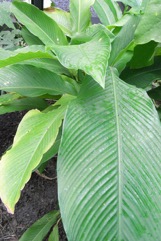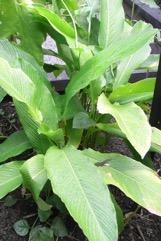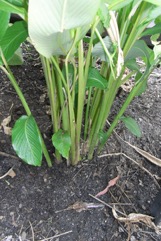Guinea arrowroot

It is a tropical plant. It requires a hot, even temperature. It does best with temperatures between 25-30°C. It needs a moderate rainfall. (1500-2000 mm). When there is plenty of humidity, nutrients and good soil drainage, plants do best in full sunlight. It is often grown in shade. They need soils rich in organic matter. In SE Asia it probably grows up to 600 m altitude. In Guatemala it grows to 1,400 m above sea level. Brisbane Botanical Gardens.
Also known as:
Agua bendita, Allelouia, Alleluia, Aria, Chufle, Cocurito, Curcuma d'Amerique, Dale dale, Dali dali, Guinea arrowroot, Lairem, Laren, Leren, Lerenes, Lleren, Sweet corn root, Sweet corn tuber, Sweet-corm-root, Topee Tambu, Topi-tambu, Topinambour
Synonyms
- Maranta allouia Aubl.
- Phrynium allouia Aubl.
- Also as Allouya americana (Lamk.)
- Curcuma americana Lamk.
Edible Portion
- Tubers, Root, Flowers, Leaves - flavour, Vegetable
Where does Guinea arrowroot grow?
Found in: Africa, Amazon, Antilles, Asia, Australia, Belize, Brazil, Caribbean, Central America, Colombia, Costa Rica, Cuba, Dominican Republic, East Africa, Ecuador, Egypt, El Salvador, Grenada, Guadeloupe, Guatemala, Guiana, Guyana, Haiti, Hispaniola, Honduras, India, Indochina, Indonesia, Madagascar, Malaysia, Martinique, Mexico, Nicaragua, North Africa, North America, Pacific, Panama, Peru, Philippines, Puerto Rico, SE Asia, South America, Sri Lanka, St Lucia, St. Vincent and Grenadines, Trinidad and Tobago, Trinidad, Venezuela, Vietnam, West Indies
Notes: Tubers are 6.6% protein on a dry matter basis. There are 260-300 Calathea species in tropical America.
Status: It is a commercially cultivated vegetable. They are sold in street markets.
Growing Guinea arrowroot
Cultivation: Plants are grown from rhizomes, suckers or offshoots. Plants only occasionally flower and do not produce viable seed. The tuberous roots are stored in a coo, dry place until they are transplanted. Plants are spaced about 0.5 m apart. The rhizomes produce about 20 shoots around them.
Edible Uses: The tubers are cooked and eaten. It is used in salads, stews and fish dishes. Young flower clusters are cooked and eaten. The leaves are used to wrap food to add flavour.
Production: A crop of tubers is ready 10-12 months after planting. Yields of 10 tonnes per hectare are possible. Yields per plant vary between 100 and 2,200 g.
Nutrition Info
per 100g edible portion| Edible Part | Energy (kcal) | Protein (g) | Iron (mg) | Vitamin A (ug) | Vitamin c (mg) | Zinc (mg) | % Water |
|---|---|---|---|---|---|---|---|
| Flowers | - | - | - | - | - | - | |
| Leaves - Flower | - | - | - | - | - | - |
Guinea arrowroot Photos



References
Bircher, A. G. & Bircher, W. H., 2000, Encyclopedia of Fruit Trees and Edible Flowering Plants in Egypt and the Subtropics. AUC Press. p 73 (Also as Calathea violacea)
Bot. Reg. 14: t. 1210. 1829
Burkill, I.H., 1966, A Dictionary of the Economic Products of the Malay Peninsula. Ministry of Agriculture and Cooperatives, Kuala Lumpur, Malaysia. Vol 1 (A-H) p 406
Cobley, L.S. (rev. Steele, W.M.) 2nd Ed., 1976, An Introduction to the Botany of Tropical Crops. Longmans. p 127
Ekman Herbarium records Haiti
Facciola, S., 1998, Cornucopia 2: a Source Book of Edible Plants. Kampong Publications, p 148
Gragson, T. L., 1997, The Use of Underground Plant Organs and Its Relation to Habitat Selection among the Pume Indians of Venezuela. Economic Botany, Vol. 51, No. 4, pp. 377-384
Hedrick, U.P., 1919, (Ed.), Sturtevant's edible plants of the world. p 142
Hermandez Bermejo, J.E., and Leon, J. (Eds.), 1994, Neglected Crops. 1492 from a different perspective. FAO Plant Production and Protection Series No 26. FAO, Rome. p 20, 239
INFOODSUpdatedFGU-list.xls
Kay, D.E., 1973, Root Crops, Digest 2, Tropical Products Institute, London, p 180
Kays, S. J., and Dias, J. C. S., 1995, Common Names of Commercially Cultivated Vegetables of the World in 15 languages. Economic Botany, Vol. 49, No. 2, pp. 115-152
Kiple, K.F. & Ornelas, K.C., (eds), 2000, The Cambridge World History of Food. CUP p 1782
Lim, T. K., 2015, Edible Medicinal and Non Medicinal Plants. Volume 9, Modified Stems, Roots, Bulbs. Springer p 20
Macmillan, H.F. (Revised Barlow, H.S., et al) 1991, Tropical Planting and Gardening. Sixth edition. Malayan Nature Society. Kuala Lumpur. p 336
Martin, F.W., and Cabanillas, E., 1976, Leren (Calathea allouia), a little known tuberous Root crop of the Caribbean. Economic Botany 30:249-256.
PROSEA handbook Volume 9 Plants yielding non-seed carbohydrates. p168
Purseglove, J.W., 1972, Tropical Crops. Monocotyledons. Longmans p 335
Smith, N., Mori, S.A., et al, 2004, Flowering Plants of the Neotropics. Princeton. p 459
Smith, P.M., 1979, Topee tambu, in Simmonds, N.W., (ed), Crop Plant Evolution. Longmans. London. p 316
Staples, G.W. and Herbst, D.R., 2005, A tropical Garden Flora. Bishop Museum Press, Honolulu, Hawaii. p 697
Terra, G.J.A., 1973, Tropical Vegetables. Communication 54e Royal Tropical Institute, Amsterdam, p 34
USDA, ARS, National Genetic Resources Program. Germplasm Resources Information Network - (GRIN). [Online Database] National Germplasm Resources Laboratory, Beltsville, Maryland. Available: www.ars-grin.gov/cgi-bin/npgs/html/econ.pl (10 April 2000)
Vael, L., 2015, Ethnobotanical study of the plant use in the natural landscape of two mestizo communities in the Ucayali region of the Peruvian Amazon. Universiteit Gent.
van Wyk, B., 2005, Food Plants of the World. An illustrated guide. Timber press. p 386
Villachica, H., (Ed.), 1996, Frutales Y hortalizas promisorios de la Amazonia. FAO, Lima. p 323